Throwing my hat into the DIY ring has always been a thrill. I’m going to share some of my favorite tips and tricks to create your own Cushions For DIY Sofa. We’ll explore everything from top brands to no-sew options, and even dive into cushion care.
So whether you’re a seasoned DIYer or just dipping your toes in, stick around! You’re sure to find something that sparks your creativity and brightens up your living space with Nousdecor!
Key Takeaways
- Higher-density foam offers firmer support (see achieving firmer sofa cushions at home), while lower-density foam is softer.
- High-density foam is more durable and suitable for heavy usage.
- Higher-density foam may be more expensive initially but provides better value in the long run.
- Adding embellishments to cushion covers, such as embroidery, appliques, or beading, enhances aesthetic appeal and increases resale value.
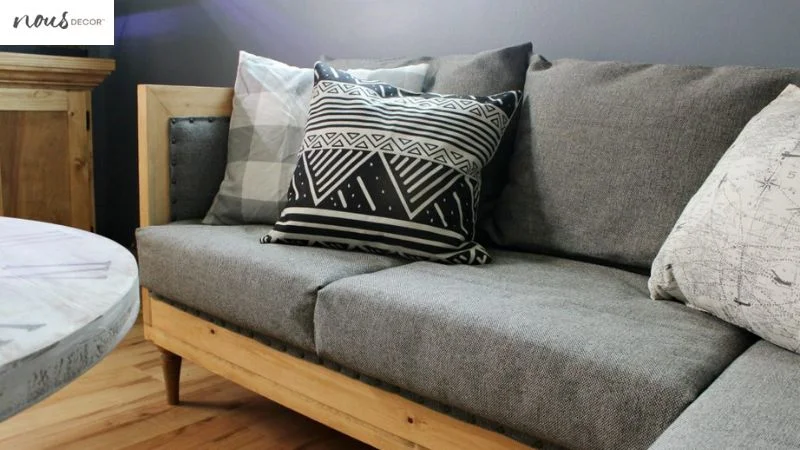
Tips For Creating Your Own Cushions For DIY Sofa
Creating your own DIY sofa cushions can be a gratifying experience, especially when armed with the right knowledge and techniques.
We’ll delve into topics such as how to choose the optimal foam density for maximum comfort, accurately measure and cut your cushion fabric, sew those covers like a pro, and finally add that unique finishing touch that will make your creation stand out.
Choosing the Right Foam Density
It’s crucial to select the right foam density for your DIY sofa cushions, as it will greatly affect comfort and durability.
This task may seem daunting when giving your old couch or old sofa a new lease of life, but with careful consideration and accurate DIY instructions, you’ll be able to achieve optimal results.
Here are the factors to consider:
- Comfort Level: Higher-density foams offer firm support while lower densities are softer.
- Durability: High-density upholstery foam cushion lasts longer.
- Usage: Heavy usage requires high-density foam.
- Budget: While higher-density foams are more expensive, they provide better value in the long run.
Once you’ve chosen your ideal foam density for your cushions for DIY sofa, we can then delve into how to measure and cut the cushion fabric accurately.
Measuring and Cutting the Cushion Fabric
You’ll need to measure and cut your upholstery fabric with precision, ensuring it fits perfectly over the foam. This is a pivotal step in making DIY outdoor cushions or couch covers. Precision is vital; a mistake here could lead to ill-fitting covers or extra work.
Here’s a quick guide:
| Task | Tools Needed | Additional Info |
|---|---|---|
| Measuring Fabric | Tape Measure | Add an inch for seams |
| Cutting Fabric | Sharp Scissors / Rotary Cutter | Cut on flat surface |
| No Sew Option | Fusible Webbing / Fabric Glue | Best for simple shapes |
| Using Sewing Machine | Sewing Machine with sturdy needle | Practice makes perfect |
| Fitting fabric onto foam | Patience & Precision! |
After measuring and cutting the cushion fabric, mastering sewing machines or opting for no sew methods becomes crucial. Ready to dive into sewing those cushion covers now?
Sewing the Cushion Covers
Once you’ve cut your fabric, it’s time to start sewing those covers together. Sewing might seem daunting but with a bit of patience and careful attention, you’ll have the perfect leather sofa cover for your outdoor sofa or indoor leather couch.
- Start by threading your overlocker.
- Next, sew each side of the cushion cover but leave one edge open for stuffing.
- Then, double-check all seams are secure – we don’t want any surprise openings!
- Finally, turn the cover right-side out through the open edge.
It’s essential to take your time during this process; precision will pay off in creating durable and beautiful cushions.
Now that our covers are crafted, let’s move on to making those cushions look and feel just right!
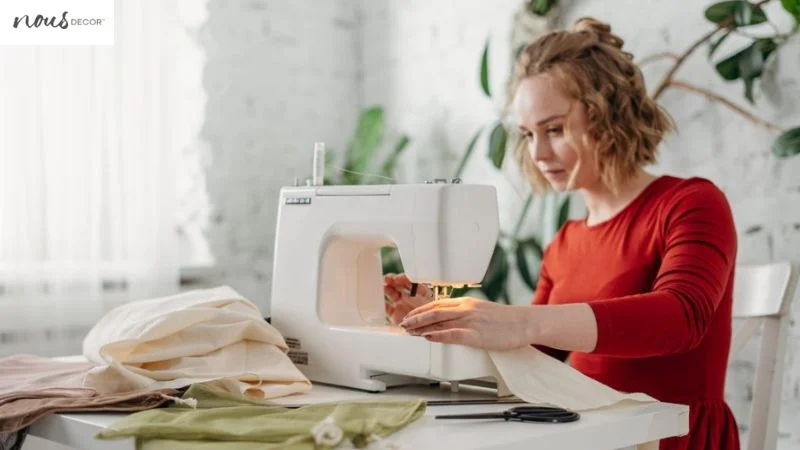
Adding the Final Touches to Your DIY Sofa Cushions
Now that you’ve sewn the covers, let’s focus on adding those final touches to make your handcrafted pieces truly stand out! Be creative and add embellishments that reflect your personal style. Consider embroidery, appliques, or even beading if you’re up for a challenge.
| Embellishment | Description |
|---|---|
| Embroidery | Add a personal touch with stitched designs. |
| Appliques | These can be pre-made or custom cut-outs sown onto the cover. |
| Beading | This takes time but the result is stunning and unique. |
Choose one or mix it all; there are no rules in expressing yourself through your creations. Remember, these details not only enhance aesthetic appeal but also increase its value should you decide to sell them later on. Now, aren’t you curious about what sofa cushion brands have to offer? Let’s explore!
Sofa Cushion Brands To Shop
In the world of sofa cushions, I’ve come across some brands that truly stand out with their impeccable designs and comfort.
LuxDecor is a name that has always fascinated me because it embodies both elegance and functionality in its products.
On the other hand, De Le Cuona and Greg Natale offer an exciting array of cushion collections, rich in texture and design—products that are worth exploring if you’re after something unique to enhance your living space.
LuxDecor
LuxDeco has a fantastic selection of cushions, perfect for any DIY sofa project. Their Thunder Grainger Cushion in Taupe and Beige Laurel Cushion are both great choices. These cushions not only add comfort but also provide an aesthetic boost to your living space.
- The Thunder Grainger Cushion in Taupe is a great option. Its earthy color adds warmth to your space, while its velvet texture invites you to unwind.
- The Beige Laurel Cushion is another fantastic choice. This cushion subtly elevates your decor with its muted tone and gentle pattern (see what cushions go with beige sofa).
- LuxDeco’s cushions have a plush factor that is hard to resist. It makes your sofa more inviting and comfortable.
- LuxDeco offers a wide variety of colors, from vibrant hues to neutral tones. There’s something for every mood and taste.
As we journey through the world of cushions, next up on our list is ‘de le cuona’. This brand offers another set of remarkable options worth considering.
De Le Cuona
You’ll find de Le Cuona’s offerings quite impressive, especially if you’re looking for quality and aesthetics. Their cushions, like the Night Artist Canvas Cushion in Blue, embody a perfect blend of luxury and comfort.
Made from exquisite materials, these cushions are designed to add a touch of elegance to any DIY sofa project. With rich colors and unique textures, they transform an ordinary sofa into a statement piece that captures attention.
De Le Cuona is known for its commitment to high-quality craftsmanship which shines through in every cushion they create. They’ve truly mastered the art of creating plush accessories that leave a lasting impression.
As we delve deeper into exploring luxurious options for our DIY sofa project, let’s shift our focus next to another renowned brand – Greg Natale.
Greg Natale
Greg Natale is known for his fearless approach to interior design, and that’s clearly seen in products like the Forbes Cushion in Grey. This cushion isn’t just a throw pillow; it’s a statement piece adding an unexpected twist to any DIY sofa project.
Four reasons make this cushion truly stand out:
- Bold geometric design: It screams modern sophistication.
- Quality fabric: Its velvet feel adds a touch of luxury.
- Versatility: The grey color effortlessly blends with different interiors.
- Size: Ideal for maximizing comfort and style on your sofa.
So, while sewing might seem daunting or even unnecessary, using designer cushions like Greg Natale’s can elevate your DIY sofa instantly.
Speaking about not wanting to sew, let’s delve into some no-sew options for making cushions next!
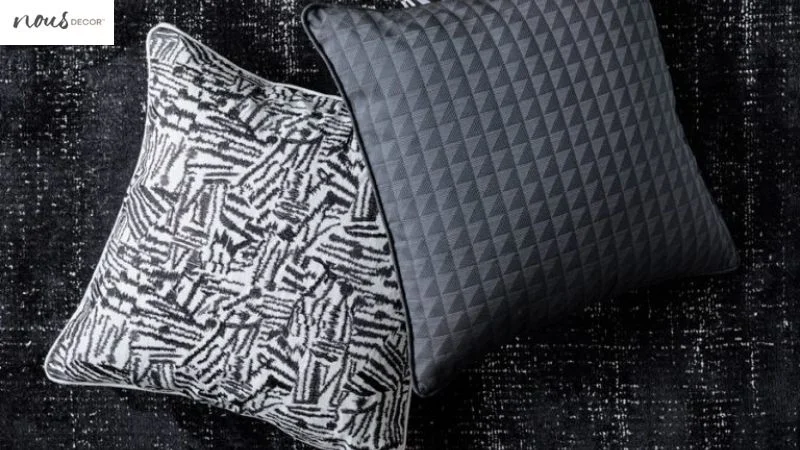
No-Sew Options: Making Cushions Without a Sewing Machine
It’s possible for creating your own sofa cushions for your DIY sofa without needing a sewing machine, thanks to no-sew options.
One popular method is using fusible web tape, an adhesive that bonds fabric together when ironed. You’d simply cut two pieces of fabric slightly larger than your cushion size, place the adhesive between them and iron over until they’re securely bonded. This also prevents small items found in couch cushions to fall into the gaps.
Another option is creating a knot-tie cushion cover – it’s as easy as cutting four slits at each corner of your fabric piece and tying them together around the cushion. It not only gives a unique aesthetic appeal but also allows for easy removal if you want to change up the style or wash the cover.
Fabric glue can also be used in lieu of sewing – just ensure it’s designed specifically for fabrics so it retains flexibility once dried, keeping couch cushions in place. This method involves applying glue along the edges of your fabric pieces and pressing them together until dry.
Having made these gorgeous no-sew cushions, I’m sure you’ll want to keep them looking their best! In my next section, let’s delve into how to properly care for and maintain your Best Sofa cushions.
Caring for Your DIY Sofa Cushions: Cleaning and Maintenance Tips
Maintaining your homemade seating accessories involves regular cleaning and timely maintenance, ensuring they’ll always look their best. I’ve learned that taking care of my DIY sofa cushions is not as daunting as it might seem. It’s all about consistency and using the right techniques.
Here are four tips that I’ve found incredibly helpful:
- Regular Vacuuming: By vacuuming my cushions weekly, I’m able to remove dust particles before they settle into the fabric fibers.
- Spot Cleaning: Accidents happen! When they do, I promptly blot out stains with a clean cloth and mild soap solution.
- Deep Cleaning: Every six months or so, I remove cushion covers (if applicable) for a thorough wash according to their specific care instructions.
- Rotation: Just like flipping a mattress, rotating cushions helps ensure even wear and tear.
- Replace when expired: Check out our steps to replace sofa cushions when your cushions are beyond help.
Remember: The key isn’t just making great cushions; it’s also keeping them in top-notch condition. In this way, you’re preserving not only your hard work but also the comfort and style of your living space. Trust me – these simple steps can prolong the life of your beloved DIY sofa cushions significantly!
Frequently Asked Questions
Conclusion
Creating my own DIY sofa cushions has been a journey, not a destination. It’s like painting a masterpiece – each layer adding depth and comfort to my home.
I’ve learned how to choose brands, create without sewing, and even maintain them for longevity. Now, I can comfortably say that with the right tools and patience, making your own cushions is as easy as pie and absolutely worth it!

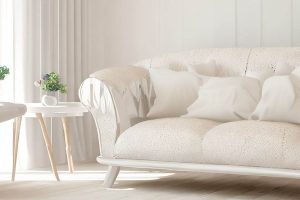
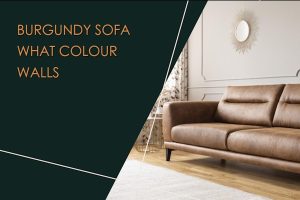
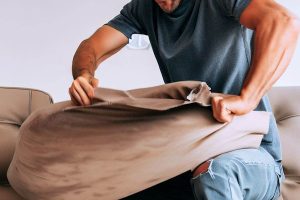

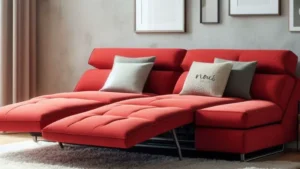
![Sofa vs Couch: Which Is BEST Choice For You? [2024]](https://nousdecor.com/wp-content/uploads/2021/06/Sofa-vs-Couch-300x197.jpg)